Micro-Trains Line Canadian National Inspection Car
Published: 2025-01-01 - By: CNW400
Last updated on: 2024-11-20
Last updated on: 2024-11-20
visibility: Public - Headline
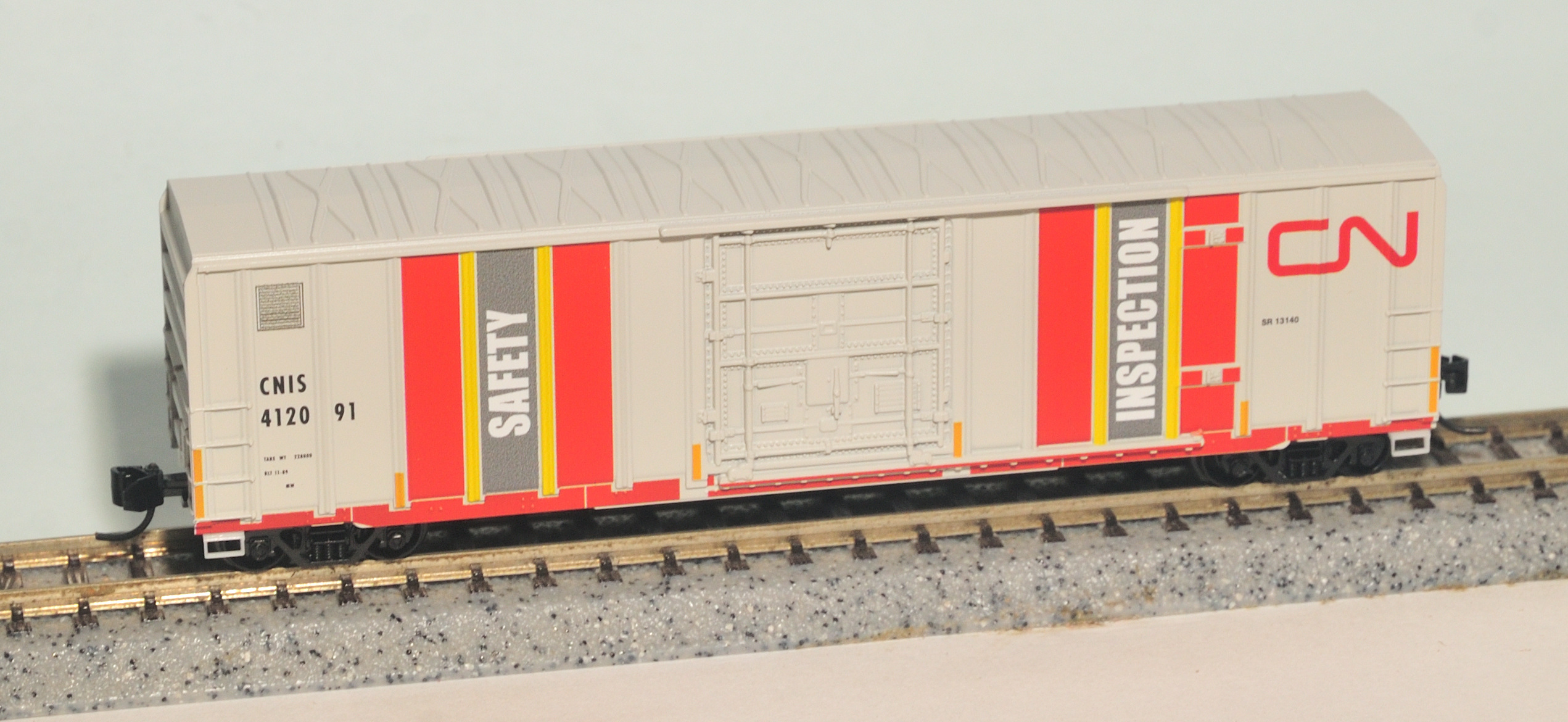
Introduction
Canadian National Railways released its first new generation autonomous track inspection program (ATIP) railcar near Chicago, Illinois in November 2019. The ATIP car was equipped to inspect track at revenue speed without interrupting day-to-day activities. Canadian National (CN) began developing and testing autonomous inspection systems (a device capable of operating without direct human control) in 2016.The Prototype
The ATIP car generates a three-dimensional picture of rail shape, rail distance, and track alignment irregularities utilizing LiDAR technology. LiDAR (Light Detection and Ranging) is a remote analysis process that uses light as a pulsed laser to measure distances. Real-time conditions of plates, spikes, ties, and ballast are also generated with LiDAR.According to the U.S. Federal Railroad Administration, Canadian National Railways maintains the largest fleet of ATIP cars in North America including autonomous geometry cars, staffed geometry cars, hi-rail geometry vehicles, and hi-rail ultrasonic track test vehicles. Hi-rail inspection cars are vehicles that can operate on railroad tracks and roadways. These dual-mode vehicles are equipped with traditional rubber tires and retractable steel flanged wheels that can be lowered and raised onto train rails. Hi-rail vehicles usually run at slower speeds then revenue trains, thus clogging the tracks and delaying the delivery of goods.

The Canadian National geometry inspection cars are rebuilt 50-foot boxcars with Barber Roller Bearing trucks that allow the car to travel at freight train speed. The cars are furnished with solar roof panels and generator power to provide continuous data collecting. Wireless communications report the status of rail curvature, alignment, smoothness, and warpage. Furthermore, global positioning can pinpoint the exact location of defects needing repair or replacement.
ATIP data reports reduce the need for manual inspections and measures beyond what the naked eye can see. Information gathered can be used for proactive maintenance and safety planning – creating a more reliable rail system.
Although ATIP cars can be placed on any type of train and located anywhere amongst the train’s rolling stock – I have typically found them hooked-up at the head of the train directly behind the locomotive power. Furthermore, all ATIP cars display a ‘1202’ hazmat placard with the supply of fuel onboard for the power generator. The code ‘1202’ identifies the presence of gasoline, oil, diesel fuel, or heating oil – all flammable and combustible liquids.

Federal regulations require any freight container, railcar or transport vehicle carrying a hazardous material display a warning placard on each side and end. The diamond-shaped placards use a four-digit number system to identify the explosive, flammable, or toxic substance. Goods that are regulated by the United Nations Committee of Experts are given a ‘UN Number’ ranging from 0004-3534. The placard number must be visible from all directions. Substances not regulated by the United Nations and transported throughout North America are managed by the United States Department of Transportation and are assigned a ’DOT Number’ between 8000-9279.

Additionally – hazardous substances are divided into classifications based on their risk, chemical reaction, and flammability. The colors, words, and graphics found on hazmat placards alert the public, cargo handlers, and first responders what hazardous material is being shipped in case of emergency - informing personnel how to respond to prevent injury and/or property damage.
Pricing & Road Names
Micro-Trains Line introduced the 50-foot ribbed plug door boxcar without roofwalk in the early 1980’s with a suggested retail price of $8.40. Since that time, nearly 200 unique models have been released of this prototype by Micro-Trains.Recently, Micro-Trains Line has introduced two track geometry inspection cars.
First in May 2024, Kansas City Southern 60-foot Excess Height track inspection car #112378 (123 00 090) with a retail price of $53.98. Our subject model followed shortly thereafter later in the month – Canadian National 50-foot ribbed plug door boxcar #412091 (027 00 500) with a sticker price of $35.98.
The Model
The Canadian National inspection car came package in a clear jewel case with a slip-off cover and one-piece plastic holder to support the model. A thick plastic insert protected the exposed surface from any scuffmarks. The model information is neatly labeled on the end of the case and a brief description of the prototype is found on the bottom panel. Inside the jewel case we find a multi-piece kit with modeler installed laser cut solar panels, resin underframe sensors, and assembly instructions.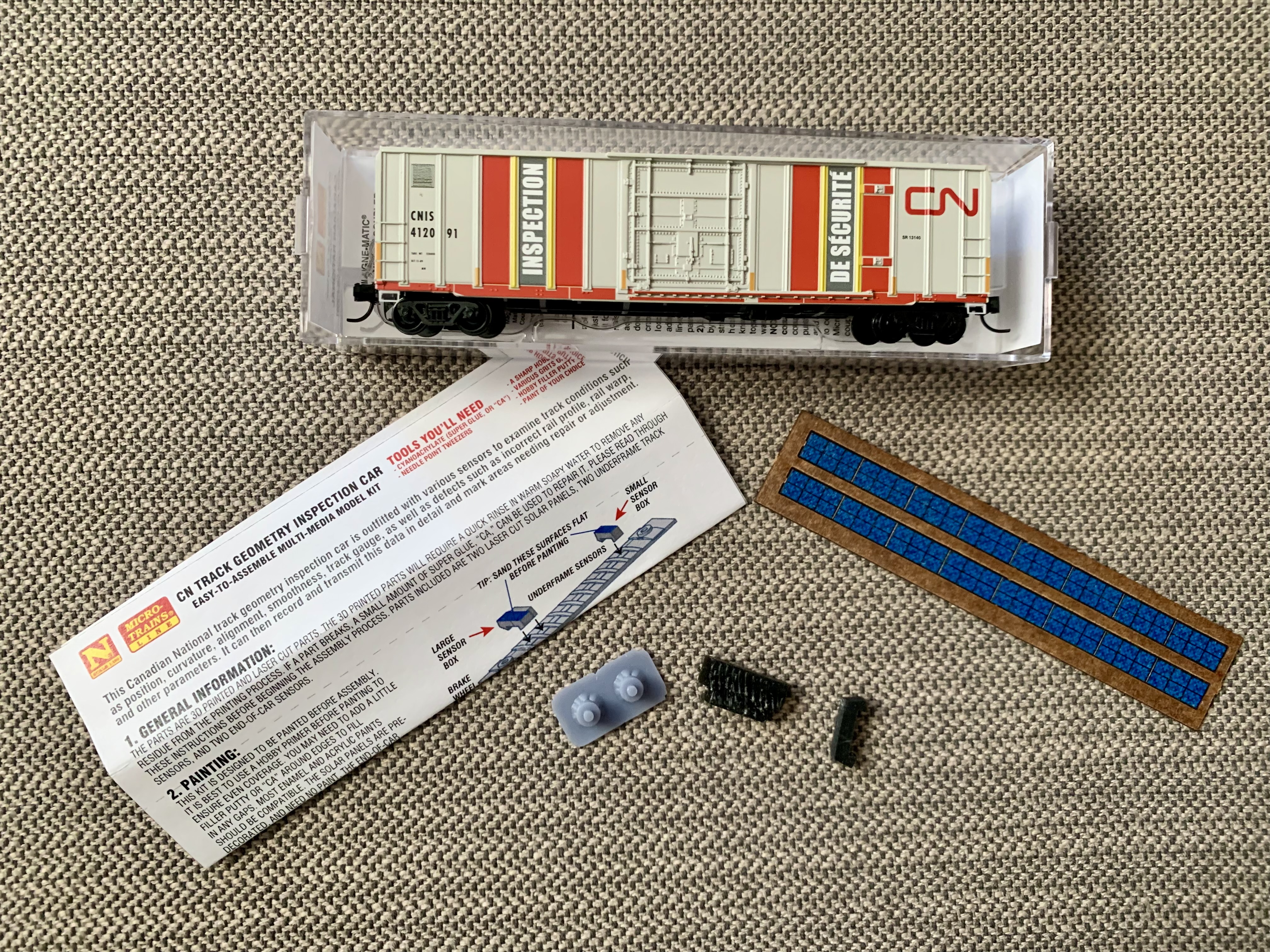
The light grey boxcar had a clean and even paint job along the entire injection molded plastic body. Bold red, yellow, and charcoal grey vertical stripes immediately grab your attention. Your eye is also drawn to the large, bright red CN ‘Fleming’ logo. The familiar CN arrangement was created by graphic designer Allan Fleming in 1960 – replacing the dated maple leaf emblem. Additionally unique to Canadian National rolling stock is the inclusion of both English and French lettering.
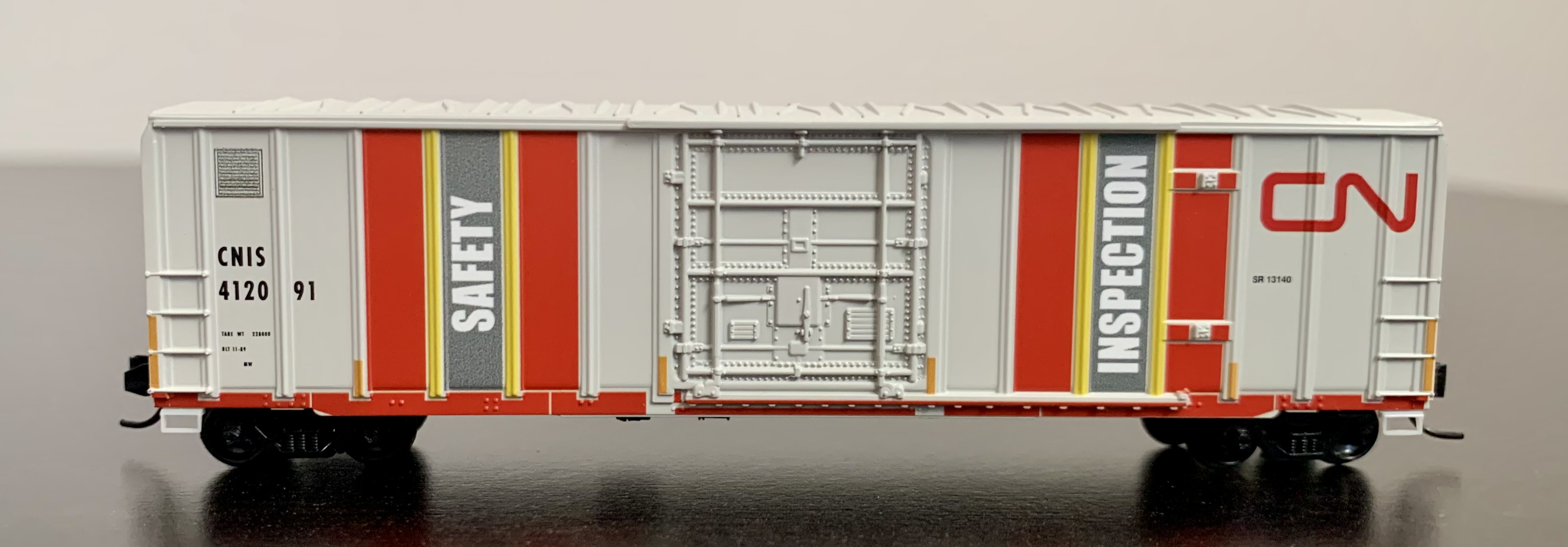
The CNIS reporting mark signifies a Canadian-built car used for international service. CNA are American-built cars either owned or leased by Canadian National Railway. Of course, CN is the proper and most used reporting mark for any rolling stock and locomotive power assigned to Canadian National.
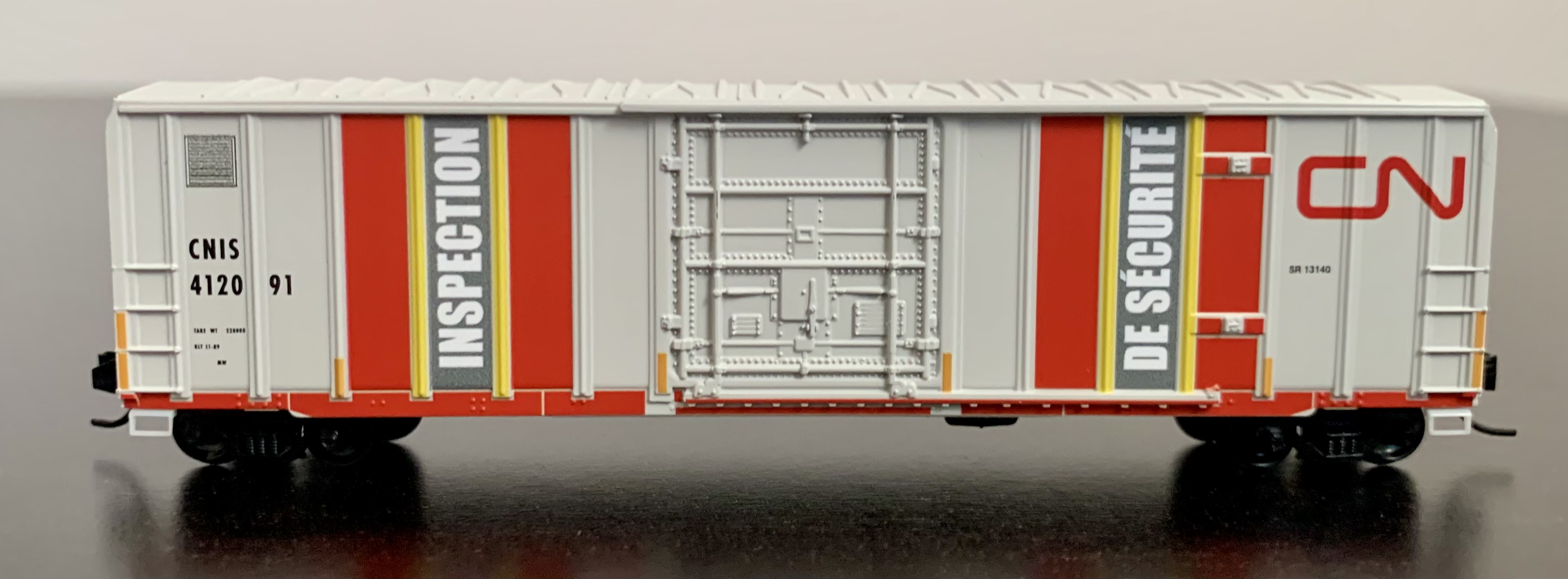
The 50-foot ribbed side plug-door boxcar model does feature the prototype correct 7x7 panel configuration on each side of the door. Also accurate are the four-rung end grab irons and all graphic placements – including conspicuity stripes. These bright yellow retroreflective markings are required by the Federal Railroad Administration (FRA) on all rolling stock – sparkling when light reflects off them, warning of potential danger ahead.
With the said, there are many dissimilarities between the Micro-Train Line model and the true-life CNIS 412091 boxcar. First, the Micro-Trains model is missing several of the side vents and sensory panels found on the prototype car. All Canadian National autonomous track inspection cars are marked with the ‘1202 – fuel onboard’ hazmat placards on all four sides (see above). Those placards are missing on the model. While both the model and prototype appear to be equipped with a Youngstown plug-door, the real-life inspection car has a much simpler door design without the rivet lines and route boards found on the model. Finally, for the more discerning modeler, the model is fitted with different side sills and stirrup steps as the prototype. The prototype as a longer notch cut-out to allow easier access to the trucks. Also, the end stirrups have the bent rung design on the real CNIS 412091 – unlike the square shaped found on the model.
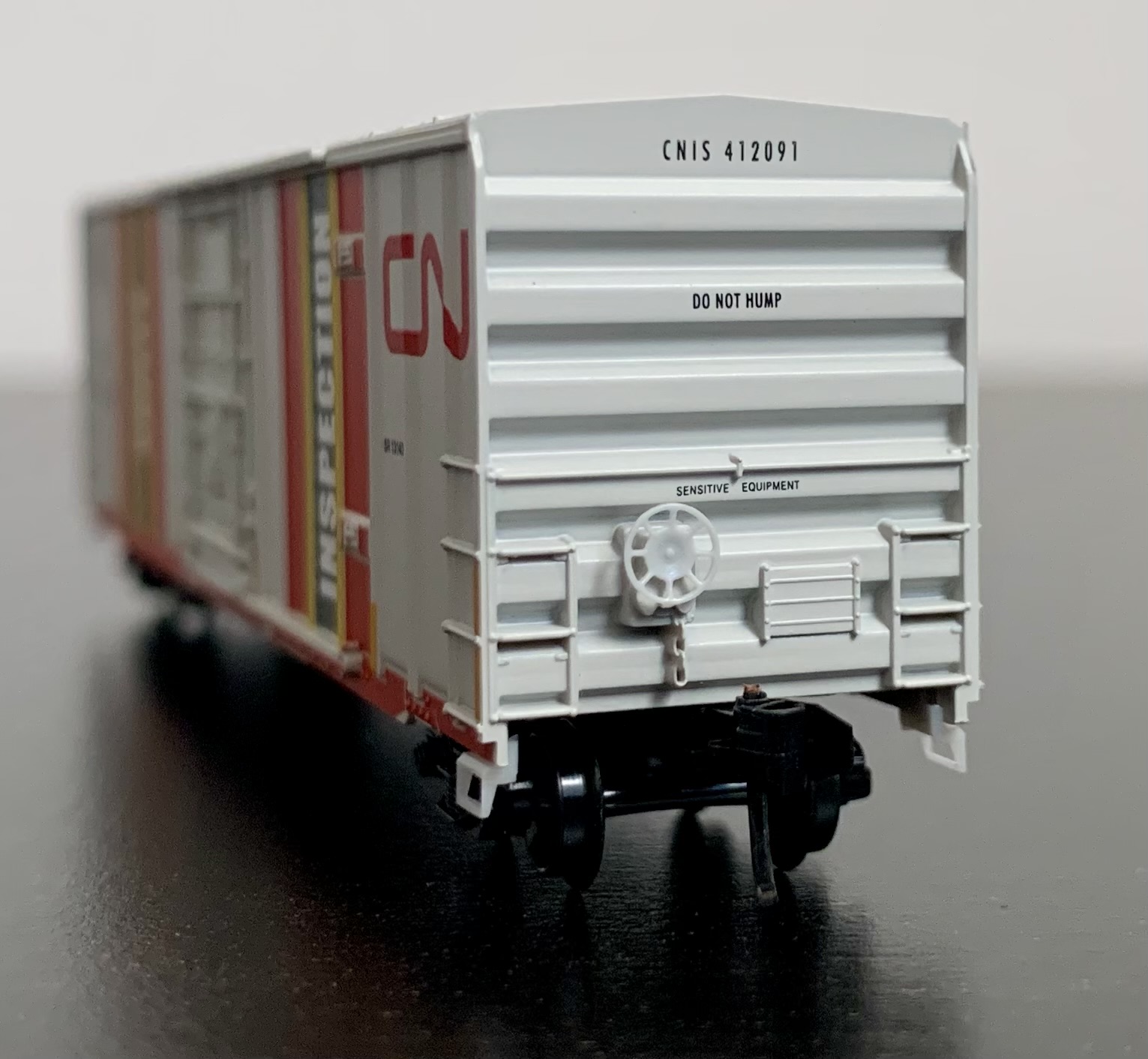
At the ends, we find some more contrasting details. The Micro-Trains model displays Stanray steel welded six non-terminating box corrugations car ends. Non-terminating ends are bolted or welded to the corner post and do not wrap around the sides of the car. The prototype inspection car has ten non-terminating corrugation ends with a welded center seam. As mentioned, the hazmat placards are also missing. The peaked roofline with road markings centered, low mounted brake gear, and three rung end stirrups are similar on both the model and prototype cars.
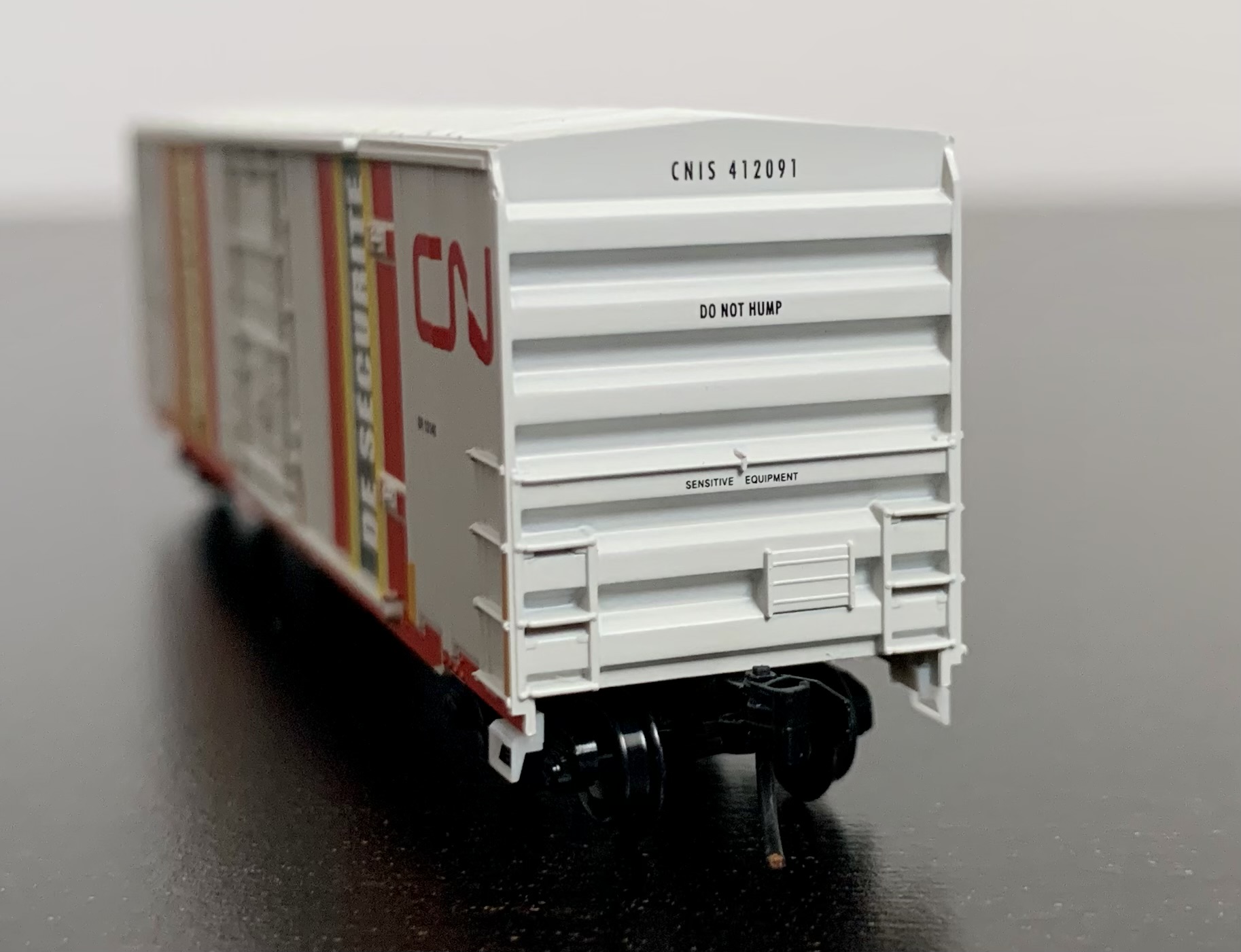
The top of the boxcar displays a welded ‘X-pattern’ Stanray eleven-panel non-overhanging metal roof. The model also features the proper raised roof panel line with no running boards. Running boards were not mandatory on new equipment built after 1966 with a target date of 1974 to have running boards removed from all rolling stock. The deadline was extended to 1983 to allow removal during normal maintenance cycles. The black underframe features separately applied brake reservoir, cylinder, and valve. The boxcar rides along body mounted Micro-Trains Line Magne-Matic couplers with Barber Roller Bearing trucks and black plastic wheels.
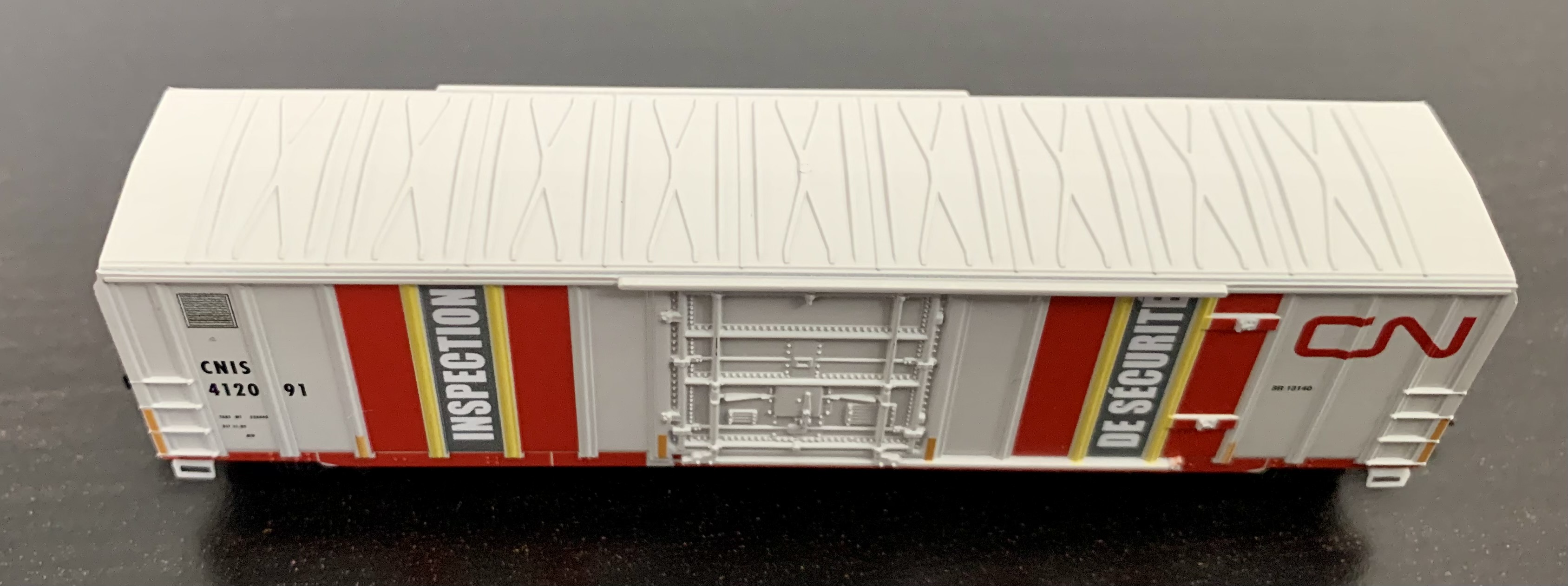
The car measures 3 3/4 inches in length and weighs 0.9 ounces, which is light according to the National Model Railroad Association (NMRA) recommendations (which is 1.09 ounces for a car of this size). The car felt very light in my hand. But the inspection boxcar was a fine runner while testing the car on Kato Unitrack with no issues around curves and through turnouts at slow and medium speeds. Both body mounted couplers measured to the correct height. The minimum recommended radius is 9 ¾ inches.
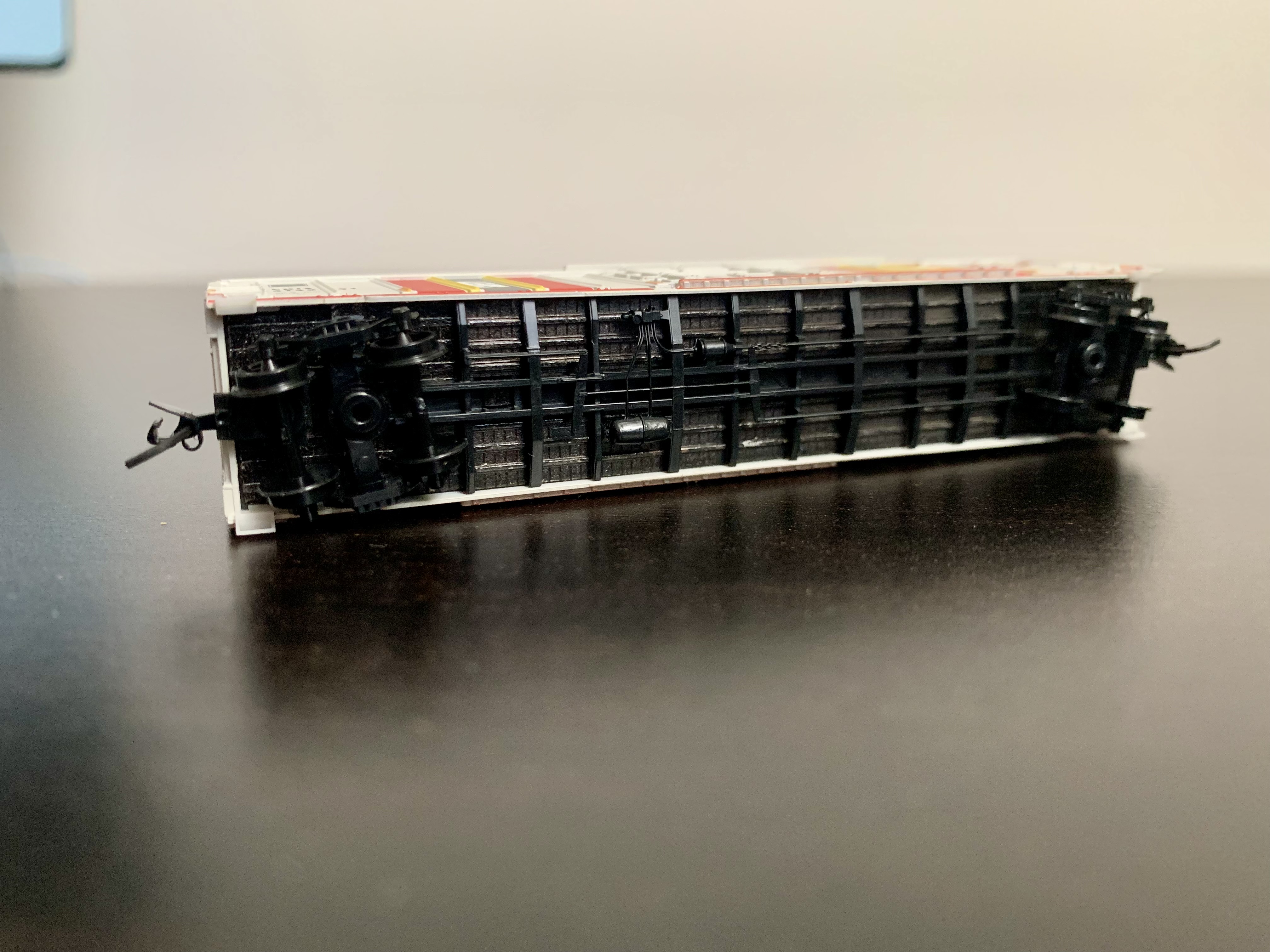
If you wish to run your Canadian National inspection car closer to true-life operations – Micro-Trains supplied a multi-media kit containing solar roof panels and various sensors. Some sanding, painting, and gluing is required to attach these detail pieces.
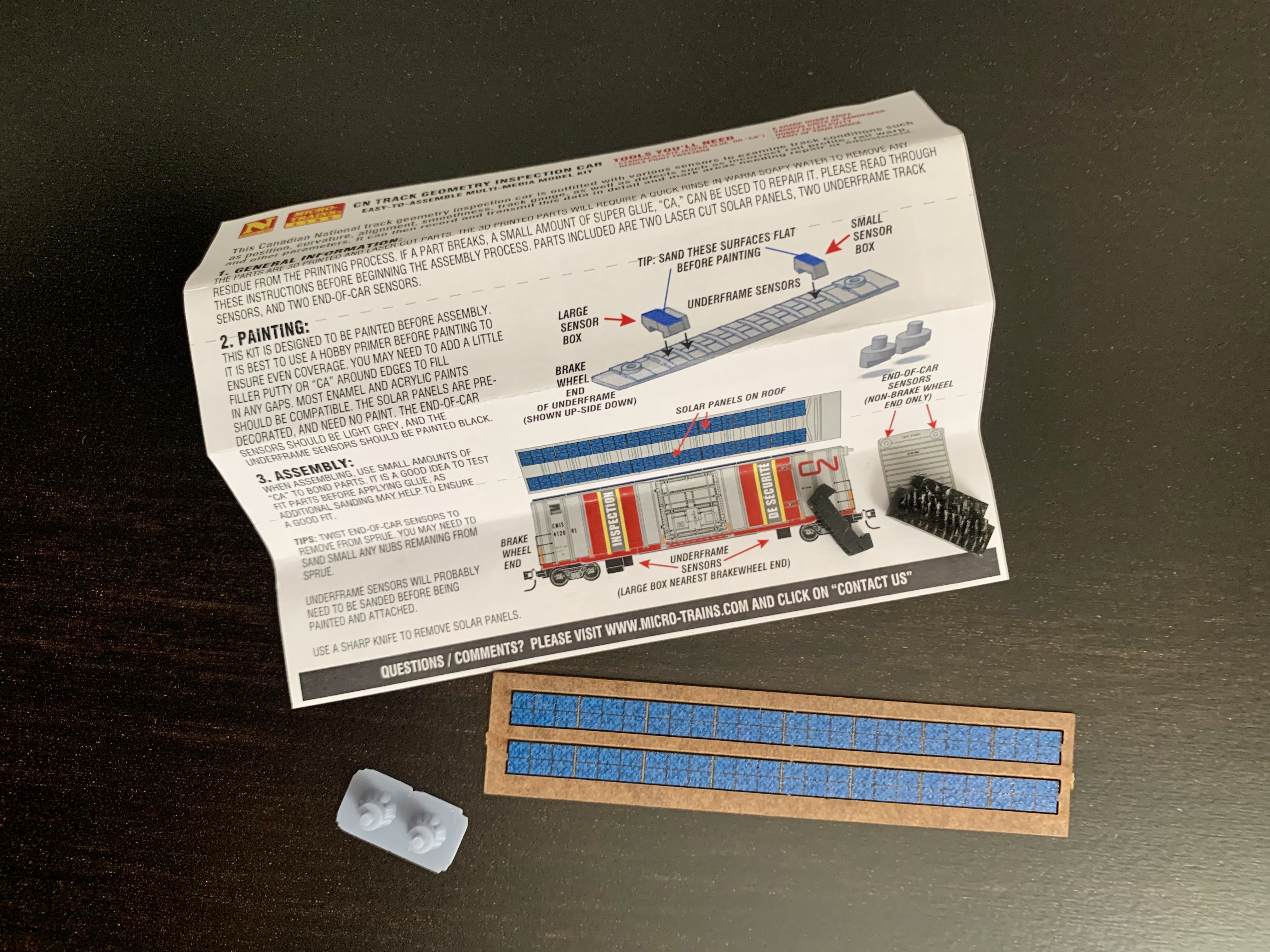
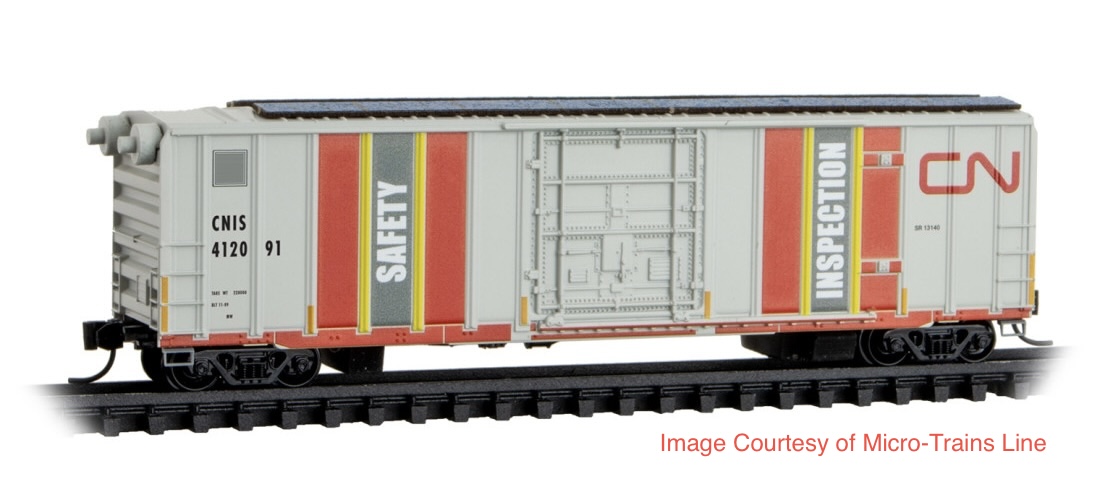
In short – Micro-Trains delivers what you except…a high-quality product that is well-built with excellent color and top-of-the-line coupler systems. Also appreciate the release of an uncommon modern piece of rolling stock. But also as excepted are molded detail parts (stirrups and ladders) and lack of model specific characteristics (car ends, missing placards and vents). The classic case of using on-hand tooling to represent modern railroad equipment. But under closer inspection – it is still a fine-looking car and will find a home on my rails – flaws and all.
Photo Credits
CN Ford road-rail vehicle in Brampton, Ontario www.commons.wikimedia.org. Photograph by Milan Suvajac April 2017. This file is licensed under the Creative Commons Attribution-Share Alike 4.0 International license.Hazardous Materials Markings, Labeling, and Placarding Guide U.S. Department of Transportation (chart edited for space)
Micro-Trains Line. www.micro-trains.com
All other photographs taken by author.

